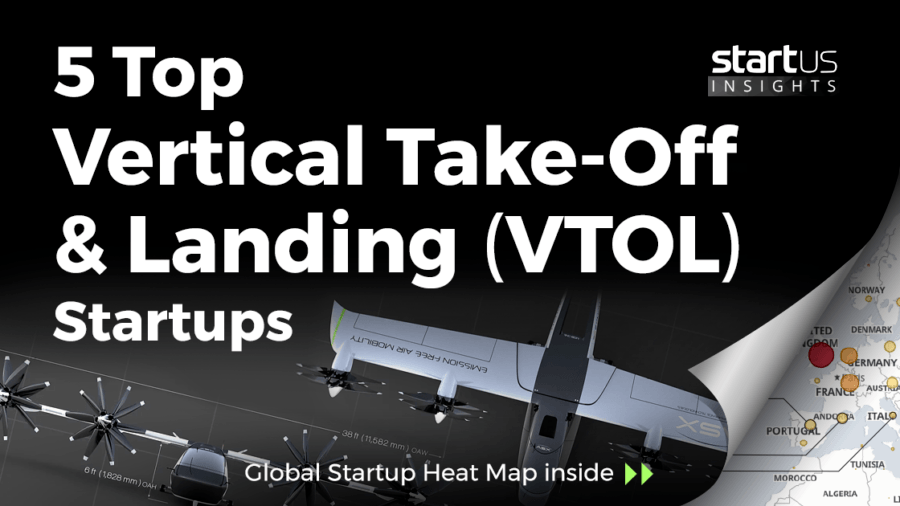startus-insights analyzed 449 vertical take-off and landing startups. VOX Aircraft, Ascendance Flight Technologies, Samad Aerospace, Airspace Experience Technologies & Aliptera develop 5 top solutions to watch out for. Learn more in our Global Startup Heat Map!
Our Innovation Analysts recently looked into emerging technologies and up-and-coming startups. As there is a large number of startups working on a wide variety of solutions, we want to share our insights with you. This time, we are taking a look at 5 promising vertical take-off & landing startups.
Heat Map: 5 Top Vertical Take-Off & Landing Startups
Using our StartUs Insights Platform, covering 1.116.000+ startups & emerging companies, we looked at innovation in the field of aviation. For this research, we identified 449 relevant solutions and picked 5 to showcase below. These companies were chosen based on a data-driven startup scouting approach, taking into account factors such as location, founding year, and technology among others. Depending on your specific criteria, the top picks might look entirely different.
The Global Startup Heat Map below highlights 5 startups & emerging companies developing VTOL solutions. Moreover, the Heat Map reveals regions that observe a high startup activity and illustrates the geographic distribution of all 449 companies we analyzed for this specific topic.
VOX Aircraft – Fully-Enclosed Rotors
Air travel involves going to the airport well in advance, clearing all the security protocols, and checking in the baggage. Even if the actual flight time is just 30 minutes, the whole process could be 2-3 hours on both ends of the journey. Personal aviation solutions that are capable of vertically taking-off and landing save time and simplify the concept of aerial mobility.
US-based startup VOX Aircraft manufactures sub-scale and full-scale fixed-wing aircrafts capable of VTOL. A patented fully enclosed rotor design enables the aircraft to reduce the risk of rotor strikes and equips it to land safely even in tight spots. This design involves an even number of rotors along the aircraft’s’ center of gravity. Additionally, the aircraft features a fixed-wing design for improved mobility.
Ascendance Flight Technologies – Hybrid Propulsion
The initial climb and final descent are dangerous as the aircraft has little or no room for errors and error recovery. In aircraft that feature VTOL systems, acceleration for mobility happens at high altitudes, where the risk of errors is significantly lower and recoveries are also manageable.
French startup Ascendance Flight Technologies produces a hybrid propulsion system-enabled aircraft. This system utilizes both vertical and horizontal propulsion alternatively or together to achieve aerial stability resulting in safer air travel. Moreover, the aircraft has a long-range of flying, low noise signature, and significantly lower operational costs compared to traditional means.
Samad Aerospace – Hybrid Electric Business Jet
Renewable sources of power in aviation triggers a positive shift toward environmental safety due to the damage fossil fuels cause. Electric powered or hybrid engines combined with innovative propulsion systems help emerging companies find solutions for optimal and efficient flying.
British startup Samad Aerospace creates a hybrid-electric aircraft enabled with VTOL. e-STARLING is a business jet that has a hybrid turbofan diesel engine and is fully electric when taking-off and landing. This aircraft seats a maximum of 7 people and has a range of approx. 640 km (400 miles) with a maximum cruise speed range of 480 km/h (300 mp/h).
Airspace Experience Technologies – Tilt Wing VTOL
VTOL aircraft have better maneuverability compared to normal winged airplanes. The ability to change the angles of the wings increases the maneuverability of any aircraft. These types of aircraft are ideal for transporting troops to and from battle zones. Apart from military applications, startups are developing solutions for commercializing aerial mobility.
US-based startup Airspace Experience Technologies creates a lightweight aircraft featuring VTOL. The startup combines automation, lightweight materials, and electric potential in their aircraft, MOBi-ONE. This aircraft has a tiltable wing system that is operable both by the pilot and autonomous systems. The range of electric flying is limited to approx. 105 km (65 miles) whereas, in hybrid, the range is extended to 418 km (260 miles). MOBi-ONE is designed to carry both passengers and cargo limited to a maximum payload of around 500 kg (1.100 pounds).
Aliptera – Personal VTOL Aircraft
Door to door traveling by air is not yet possible unless people their own personal helicopters. Being able to travel short distances of 100-300 kilometers (62 – 186 miles) by aircraft efficiently is a promising enterprise. As a result, technology companies develop VTOL solutions to enable the commercialization of short-distance flying for everyone.
Canadian startup Aliptera develops a small personal VTOL aircraft. This startup uses Lipwing technology and a computerized flight controller for aerial mobility, take-off, and landing. This aircraft’s specifications include a 180 HP engine generating 780 kg (1.720 pounds) of thrust and a range of 772 km (480 miles) at a maximum speed of 210 knots.
What About The Other 444 Solutions?
While we believe data is key to creating insights it can be easy to be overwhelmed by it. Our ambition is to create a comprehensive overview and provide actionable innovation intelligence so you can achieve your goals faster. The 5 vertical take-off & landing startups showcased above are promising examples out of 449 we analyzed for this article. To identify the most relevant solutions based on your specific criteria, get in touch.
News Source: StartUs Insights


